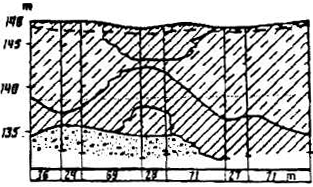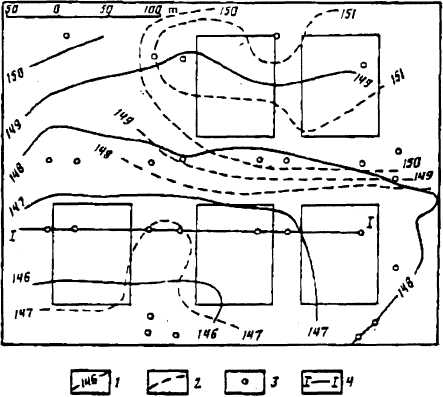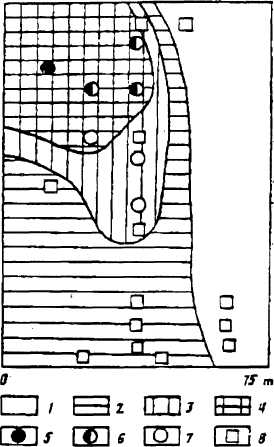Лаборатория геологии техногенных процессов
Maksimovich N.G., Gorbunova K.A. Change in hydrogeological conditions during construction of a large agroindustrial complex // Soviet Engineering Geology (Inzhenernaya Geologiya), 1989.- N5.- P.52-56.
CHANGE in HYDROGEOLOGICAL CONDITIONS DURING CONSTRUCTION of a LARGE AGROINDUSTRIAL COMPLEX
N. G. Maksimovich and K. A. Gorbunova
The change in the hydrogeological and engineering geological conditions in the process of the construction of a large object in the Perm Oblast is demonstrated. the rise in the level of the ground water and its salinization to 15 g/l in one area greatly complicated the engineering geological situation. the need to organize observations of the change in engineering geological conditions in the process of construction is substantiated.
In designing industrial and civil objects the engineering geological conditions are evaluated mainly based on data from studies which precede construction and, to a lesser degree, the forecast of their change in time. One of the stages, when the geological environment is subjected to subtantial, in many cases maximal (extreme) technogenic influence, is the construction process. It is accompanied by movement of significant volumes of soil, the use of artificial material with properties which differ from natural physicomechanical, filtration, and chemical properties, which leads to a change in the hydrogeological and engineering geological characteristics of the mass.
In many cases, the design solutions adopted based on data on the natural properties of the masses do not correspond to the condition formed by the moment of completion of construction, which may be the cause of dangerous situations. Despite this, the evaluation of the engineering geological conditions which arise in the course of industrial and civil construction is not given its due attention. the authors inspection of design organizations does not always establish these situations, since the required technical means and specialists are not always available.
The subsurface hydrosphere undergoes the greatest transformation [2, 7]. Ground water is the element of the geological environment which reacts first to external influence, exchange in the hydrogeological conditions may have a direct negative effect on engineering structures (flooding) and on the soil properties, which facilitates activation of unfavorable geological processes. as researchers note [8], the cause of 80% of hazardous situations is the change in the ground water conditions during construction work.
Factors which influence the hydrogeological conditions in the construction process include rearranging of the Earth’s surface, which determines the conditions of supply and discharge of ground water, loosening or compaction of soils, creation of drains, leaks from water lines, etc. a substantial change in the composition of the ground water is noted in areas where chemically active artificial soils and materials are used.

Fig. 1. Geological cross section along line I–I (see Fig. 2) according to data of VerkhneKamTISIZ: 1) soil-plant layer, 2) loam, 3) clay, 4) gravel-pebble horizon, 5) level of upper aquifer horizon.
 Fig. 2. Schematic map of hydroisohypses: 1) in 1976, 2) in 1986, 3) borehole, 4) line of cross section (see Fig. 1).
As an example of the development of an unfavorable engineering geological situation in the construction process we may present one of the large objects in Perm Oblast. the investigated site is 25–30 in above the water line on the slope of the Yaiva R. valley, complicated in the southern area by a ravine. Bedded on the site, according to data of VerkhneKamTISIZ, beneath the soil (0,2–0,4 m) are talus loams 4,0 to 15,8 m thick, in the upper portion hard-and soft-plastic, in the lower flowing-plastic and fluid. They include lenses and seams of clay. Many boreholes reveal a gravel-pebble level at a depth of 10.5.16,3 m (Fig. 1). According to test filtration work the coefficient of filtration of loams was 0:08–0:09 m/day.
Two aquifer horizons were identified in the research period (1976): the upper in loams at a depth of 0,3–3,1 m and the lower in the gravel-pebble deposits at a depth of 10.5.13,2 m. Swampy conditions are noted in places where the upper aquifer horizon is shallow. the chemical composition of the. ground water in 1976 and 1977 was studied according to data of 20 chemical analyses. the dry residue was 80–300 mg/l with the predominance of calcium hydrocarbonate composition. with respect to concrete the water, from slightly acid to slightly alkaline, possessed weak or average leaching, general acidic, and carbonic corrosiveness.
In September 1986, in one of the units of the object under construction a bearing column settled 60 cm, causing a sag in the roof. Uncovering the foundation showed that the loss of strength of the structure is caused by the destruction of concrete and corrosion of the reinforcement by the ground water. Also noted is the settling of two columns by 10–20 cm, whose foundations were not corroded. Because of this the geological and engineering geological conditions which existed in the construction period were analyzed.
The change in the hydrogeological conditions was established by comparing maps of hydroisohypses compiled for two perios: 1976 according to data of standard observations of the VerkhneKamTISIZ and 1986 according to data from measurements of the water level by members of the Institute of Natural Science of Perm University (Fig. 2). in 1976, the ground flow followed the topography down slope toward the ravine in the southern part of the area. the creation of construction trenches, their filling with good filter material, and grading of the area were accompanied by the development of small basins of ground water with very small hydraulic slopes within individual units. Observation data in standard boreholes let us conclude that in the period from 1976 through 1986 the ground water level rose by 0,5–1,5 m almost everywhere. in fill soils it is above the natural surface of the Earth in places. Foundations and the lower parts of columns in such areas are found in waterlogged soils, which worsens the temperature and moisture conditions in the industrial spaces.

Fig. 3 Hydrochemical fields in salinization area (autumn 1986). Dry residue, g/l: 1) <1,0, 2) 1,1–3,0, 3) 3,1–5,0, 4) >5,0. Sulfate corrosion: 5) strong, 6) medium, 7) weak, 8) none.
Table 1 Chemical Composition of Ground Water in Area of Salinization, mg/l 17 September 1986
|
Sample no.
|
HCO3–
|
SO42-
|
Cl-
|
Ca2+
|
Mg2+
|
Na++K+
|
pH
|
Dry
residue
|
|
1
|
317
|
122
|
3049
|
273
|
29
|
1942
|
7,1
|
5575
|
|
2
|
348
|
41
|
8308
|
357
|
63
|
4192
|
7,1
|
10135
|
|
3
|
274
|
252
|
8847
|
437
|
51
|
5833
|
6,8
|
15582
|
|
4
|
305
|
311
|
1824
|
205
|
58
|
1200
|
7.3
|
3750
|
|
5
|
348
|
119
|
2624
|
373
|
17
|
1555
|
11,8
|
4862
|
|
6
|
73
|
2049
|
2599
|
241
|
30
|
2587
|
9,2
|
7523
|
The rise in the ground water level in one area occurred at the same time as the significant change in their chemical composition and corrosiveness. the increase in the ground water mineralization was caused by the use of a large amount of mineral salt for thawing the soil in the creation of a construction trench in the winter season. Salt trucked in from the dumps of the Verkhnekamskii deposit of potassium salts is represented mainly ay sodium chlorides with inclusions of calcium sulfates and potassium chlorides.
Mineralized, concrete-corrosive water formed as a result of the dissolving of the salt. in 1976 and 1977, the chemical composition of the upper aquifer horizon was characterized by the following indicators, which were taken as the natural background; dry residue 142, content of chlorine ions 12, sulfate ions 26, sodium and potassium ions 14 mg/l. the increase in the content of the macrocomponents in salinized areas is estimated by the coefficient of variability Kv i.e., by the ratio of the component at a given moment to the background. Chemical analyses of water samples taken in 1986 showed that the dry residue at individual points of salinized areas grew to 15 g/l, and the content of chlorine ions grew to 9 g/l (Table 1). Salts were the source not only of sodium chlorides, but also sulfates. Established in the area of one unit are hydrochemical fields which differ with respect to the content of chlorine ions, sulfate ions and dry residue (Fig. 3). in the first field, where Kv of the dry residue reached 53, chlorine 400, and sulfate ions 80, the water at many points had strong and medium sulfate corrosiveness. Upflow from the first field the composition of the water did not change, but the mineralization of the water decreased downflow with distance from the source of salinization. in a borehole situated downflow from the construction trench the dry residue lncreased negligibly (Kv=4). Thus, anomalous engineering geochemical conditions of technogenic origin formed in this area [1],
Table 2 Mineralogical Composition of Clay Fraction of Loams,
%
|
Minerals
|
Depth, m
|
|
1.0
|
1.5
|
2.0
|
2.5
|
3.1
|
|
Montmorilonit
|
58
|
76
|
67
|
55
|
70
|
|
Kaolinite
|
10
|
0
|
0
|
15
|
0
|
|
Hydromica
|
12
|
9
|
12
|
9
|
12
|
|
Chlorite
|
0
|
8
|
8
|
0
|
7
|
|
Feldspar
|
20
|
7
|
13
|
21
|
11
|
One of the causes of the settling of the foundations of columns, was probably the effect of mineralized water on the soils; it had a sodium chloride or sodium sulfate-chloride composition, and the dry residue at individual points reached 15 g/l. X-Ray diffraction.analysis of soil samples from an unsalinized area, taken from the walls of a prospecting pit at an interval of 0,5 m, Is carried out on a DRON-1,5 diffractometer. It showed that the clay minerals are dominated by montmorillonite (Table 2). According to data in the literature, for montmorillonite clays upon reaction with sodium chloride there are decreases in the deformation and strength characteristics [3, 6].
An unfavorable situation, obviously, was created by the rise in the level of the mineralized ground water and their chemical effect on bases and foundations of structures.
The example presented shows that unfavorable engineering geological conditions arise in the construction process in conjunction with the execution of both design solutions and unanticipated technogenic influences. Negative phenomena at the site became possible, since the situation which was created was determined by subjective factors and could not have been predicted, and no observations of the engineering geological situation were made during construction.
To prevent unfavorable engineering geological situations which arise in the construction process: or in the period of exploitation of the structures we must organize a special engineering geological service [5]. the task of this service should amount to observation of the state of the geological environment, substantiation and development of measures for preventing negative processes, protecting the structures from them, and evaluating their effectiveness, i.e., monitoring the geological environment [4].
REFERENCES
- S. D. Voronkevich, «Theoretical foundations of artificial lithogenesis,» in: Theoretical Foundations of Engineering Geology, Social and Economic Aspects [in Russian], Nedra, Moscow, pp. 112–145, 1985.
- E. S. Kzektser, E. L. Nekrasova, and M. V. Tikhonova, «Potential corrosiveness of ground water and organization of the subsurface hydrosphere of developed areas,» Inzh. Geologiya [Soviet Engineering Geology], no. 1, pp. 91–96 1988.
- K. S. Zaingirov, N. A. Okina, and N. A. Lavrova, «Change in physicomechanlcal properties of Khvalynskii clay rocks under the influence of acid technogenic water,» in: Change in Geological Environment Under the Influence of Human Activity [in Russian], Nauka, Moscow, pp. 5–9, 1982.
- Yu. P. Zakharov, «Engineering geological monitoring of engineering and industrial-economic development of plains areas,» Inzh. Geologiya, no. 1, pp. 3–16, 1986.
- N. G. Maksimovich, «Problems of controlling the geological environment of Industrial zones of cities,» in: Modern Problems of Engineering Geology and Hydrogeology of the Territory of Cities and Urban Complexes [in Russian], Nauka, Moscow, pp. 268–270.
- A. M. Monyushko and S. P. Pakhomov, «Major principle determining the resistance of clay soils to the effect of flooding; and industrial wastes (according to experimental data),» Inzh. Geologiya, no. 5, pp. 5–45, 1985.
- T. Paal, «Change of groundwater level-change of design parameters,» Proc. 6 th Budapest Conf. Soil Mech. and Pound, Eng., Budapest, pp. 229–235, 1984.
- L. Rethati, «Geotechnical effects of changes in groundwater level, „Soil Mech, and Foundat. Eng. Proc, 10 th Int. Conf., Rotterdam, vol. 1, pp. 47l–476, 1981.

|
|
|

